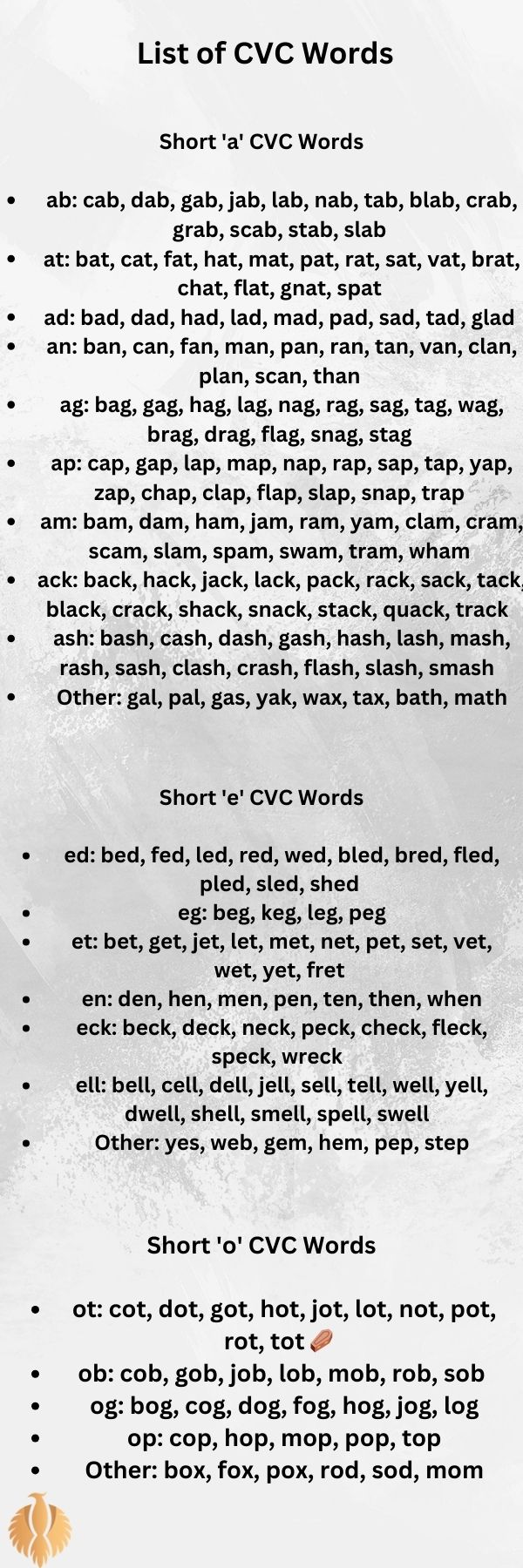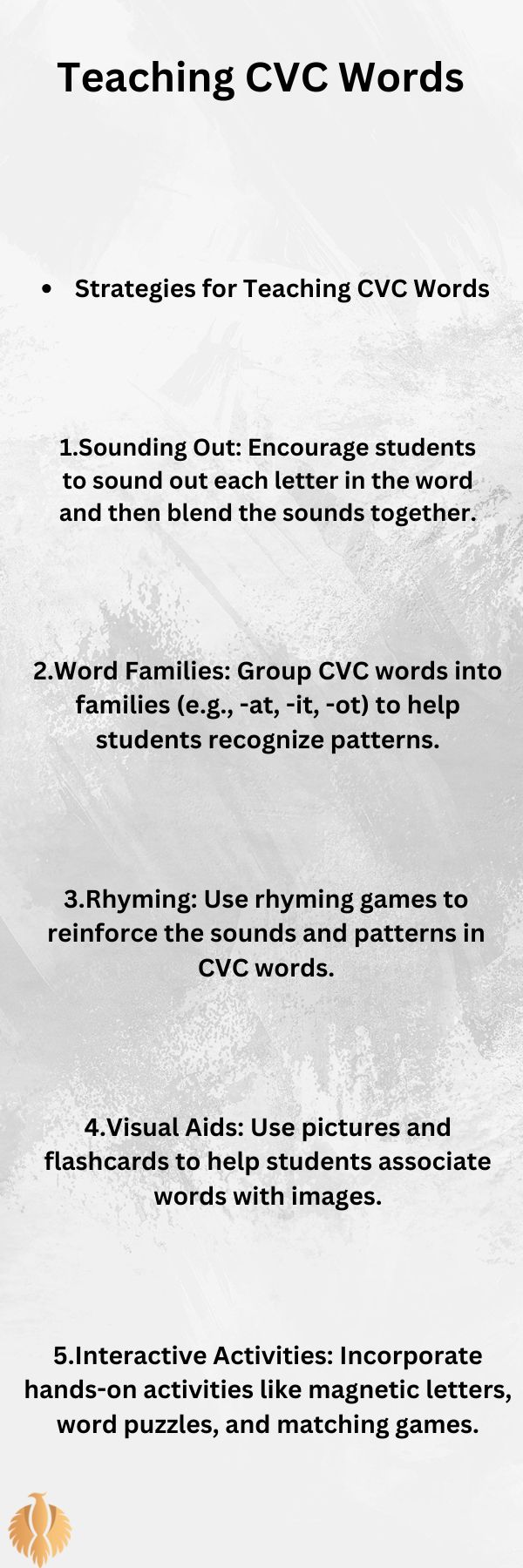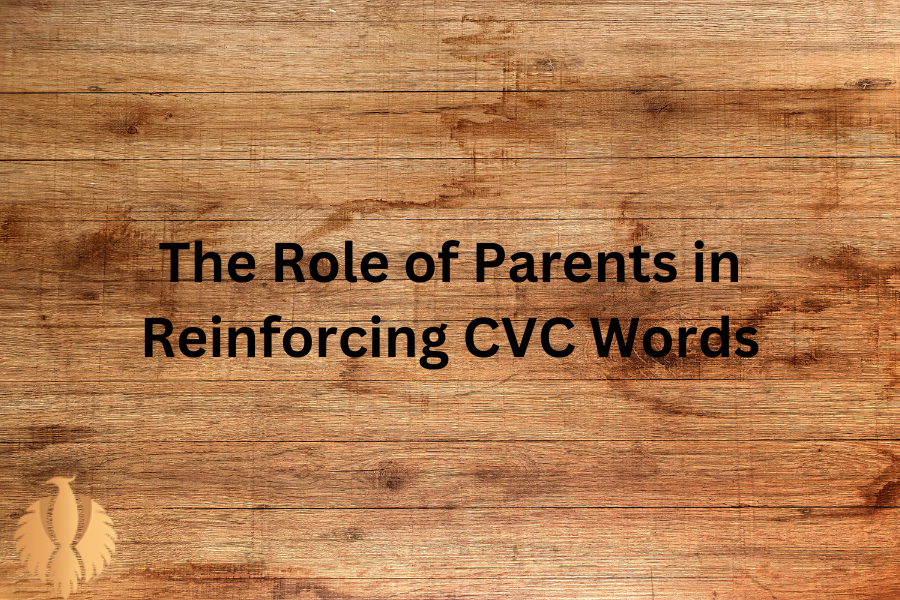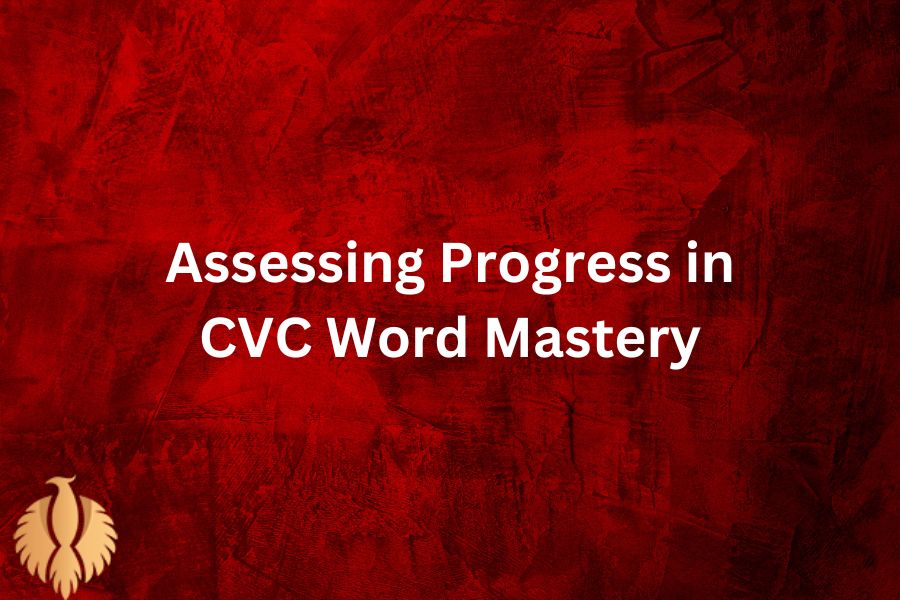CVC words are basic three-letter terms that adhere to a consonant-vowel-consonant structure. These words are fundamental in early reading and phonics education because they are easy to sound out and blend. Examples of CVC words include “cat,” “dog,” and “hat.”
Learning CVC words is crucial for developing phonemic awareness, which is the ability to hear and manipulate individual sounds in words. This skill is essential for reading and writing, as it helps learners decode words and spell them correctly.
By mastering CVC words, learners build a strong foundation for more complex words and sentences.
CVC words are particularly beneficial for young readers because they provide a straightforward and consistent structure that makes it easier to understand the relationship between letters and sounds.
This predictability helps children gain confidence as they begin to read independently. Additionally, CVC words are often some of the first words that children encounter in their reading journey, making them a key component of early literacy programs.
The simplicity of CVC words also allows for a variety of engaging and interactive teaching methods.
Educators can use games, flashcards, and hands-on activities to make learning these words fun and effective.
As children become more proficient with CVC words, they can start to explore more complex phonetic patterns and word structures, gradually expanding their vocabulary and reading skills.
You Might Also Enjoy: Top 60 Most Common Simple Sentences In English
How Are CVC Words Formed?
CVC words are formed by combining a consonant sound, a vowel sound, and another consonant sound. The vowel sound is always in the middle of the word, connecting the two consonant sounds.
The structure of CVC words is straightforward, making them ideal for early readers who are just beginning to understand the relationship between letters and sounds.
Each letter in a CVC word represents a distinct phoneme, or sound, which helps children practice phonemic awareness.
This awareness is crucial for developing reading skills, as it enables children to decode new words by sounding them out. ️
Additionally, the simplicity of CVC words allows for a variety of teaching methods. Educators can use visual aids, such as flashcards and word walls, to help students recognize and remember these words.
Hands-on activities, like building words with letter tiles or writing them in sand, can also reinforce learning by engaging multiple senses.
By mastering the formation of CVC words, children gain confidence in their reading abilities and build a solid foundation for more complex word structures.
This foundational knowledge is essential for progressing to more advanced phonics patterns and ultimately becoming proficient readers.
Complete List of CVC Words

Here is a comprehensive list of CVC words, categorized by the vowel sound they contain:
Short ‘a’ CVC Words
- ab: cab, dab, gab, jab, lab, nab, tab, blab, crab, grab, scab, stab, slab
- at: bat, cat, fat, hat, mat, pat, rat, sat, vat, brat, chat, flat, gnat, spat
- ad: bad, dad, had, lad, mad, pad, sad, tad, glad
- an: ban, can, fan, man, pan, ran, tan, van, clan, plan, scan, than
- ag: bag, gag, hag, lag, nag, rag, sag, tag, wag, brag, drag, flag, snag, stag
- ap: cap, gap, lap, map, nap, rap, sap, tap, yap, zap, chap, clap, flap, slap, snap, trap
- am: bam, dam, ham, jam, ram, yam, clam, cram, scam, slam, spam, swam, tram, wham
- ack: back, hack, jack, lack, pack, rack, sack, tack, black, crack, shack, snack, stack, quack, track
- ash: bash, cash, dash, gash, hash, lash, mash, rash, sash, clash, crash, flash, slash, smash
- Other: gal, pal, gas, yak, wax, tax, bath, math
Short ‘e’ CVC Words
- ed: bed, fed, led, red, wed, bled, bred, fled, pled, sled, shed
- eg: beg, keg, leg, peg
- et: bet, get, jet, let, met, net, pet, set, vet, wet, yet, fret
- en: den, hen, men, pen, ten, then, when
- eck: beck, deck, neck, peck, check, fleck, speck, wreck
- ell: bell, cell, dell, jell, sell, tell, well, yell, dwell, shell, smell, spell, swell
- Other: yes, web, gem, hem, pep, step
Short ‘i’ CVC Words
- it: bit, fit, hit, kit, lit, pit, sit, wit, knit, quit, slit, spit
- id: bid, did, hid, kid, lid, rid, skid, slid
- ig: big, dig, fig, gig, jig, pig, rig, wig, zig, twig
- im: dim, him, rim, brim, grim, skim, slim, swim, trim, whim
- ip: dip, hip, lip, nip, rip, sip, tip, zip, chip, clip, drip, flip, grip, ship, skip, slip, snip, trip, whip
- ick: kick, lick, nick, pick, sick, tick, wick, brick, chick, click, flick, quick, slick, stick, thick, trick
- ish: fish, dish, wish, swish
- in: bin, din, fin, pin, sin, tin, win, chin, grin, shin, skin, spin, thin, twin
Short ‘o’ CVC Words
- ot: cot, dot, got, hot, jot, lot, not, pot, rot, tot ⚰️
- ob: cob, gob, job, lob, mob, rob, sob
- og: bog, cog, dog, fog, hog, jog, log
- op: cop, hop, mop, pop, top
- Other: box, fox, pox, rod, sod, mom
Short ‘u’ CVC Words
- ub: cub, hub, nub, rub, sub, tub
- ud: bud, cud, dud, mud
- ug: bug, dug, hug, jug, lug, mug, pug, rug, tug
- um: bum, gum, hum, mum, sum
- un: bun, fun, gun, nun, pun, run, sun ☀️
- ut: but, cut, gut, hut, jut, nut, rut
- Other: pup, cup, bus
You might also enjoy: Top 100 Commonly Used Verbs That Start With D [2024]
The Role of CVC Words in Early Literacy
- Building Blocks of Reading
CVC words serve as the building blocks of reading. They are among the first words that children learn to read because they are straightforward and follow a predictable pattern.
This predictability helps children gain confidence in their reading abilities.
- Phonemic Awareness
Phonemic awareness refers to the capacity to perceive, recognize, and manipulate the distinct sounds (phonemes) present in spoken language. This skill is essential for both reading and spelling proficiency.
CVC words serve as an effective tool for enhancing phonemic awareness due to their simplicity and adherence to a consistent pattern. ️
- Decoding Skills
Decoding refers to the skill of utilizing an understanding of the relationships between letters and their corresponding sounds to accurately articulate written words.
CVC (consonant-vowel-consonant) words are particularly beneficial for children in practicing decoding, as they allow for the individual sounds of each letter to be articulated and subsequently blended to create the complete word.
Teaching CVC Words

- Strategies for Teaching CVC Words
- Sounding Out: Encourage students to sound out each letter in the word and then blend the sounds together.
- Word Families: Group CVC words into families (e.g., -at, -it, -ot) to help students recognize patterns.
- Rhyming: Use rhyming games to reinforce the sounds and patterns in CVC words.
- Visual Aids: Use pictures and flashcards to help students associate words with images.
- Interactive Activities: Incorporate hands-on activities like magnetic letters, word puzzles, and matching games.
- Importance of Phonemic Awareness
Phonemic awareness refers to the capacity to perceive, recognize, and manipulate the distinct sounds (phonemes) present in spoken language.
This skill is essential for both reading and spelling proficiency.
CVC words serve as an effective tool for enhancing phonemic awareness due to their simplicity and adherence to a consistent pattern.
You Might Also Enjoy: How To Learn English Speaking At Home: My 12 Tips
Advanced Teaching Techniques for CVC Words
- Multisensory Learning
Incorporating multisensory learning techniques can enhance the teaching of CVC words.
This approach engages multiple senses, helping students to better retain and understand the material. Techniques include:
- Tactile Learning: Using sandpaper letters or writing words in sand to feel the shapes of the letters. ✉️
- Auditory Learning: Clapping out the sounds in the words or using musical rhythms to reinforce phonemic patterns.
- Visual Learning: Color-coding the consonants and vowels to highlight the CVC pattern.
- Technology Integration
Leveraging technology can make learning CVC words more interactive and engaging.
Educational apps and online games can provide practice in a fun and motivating way. Some useful tools include:
- Interactive Whiteboards: Teachers can use these to display CVC word games and activities.
- Educational Apps: Apps like Starfall and ABCmouse offer interactive CVC word exercises.
- Online Games: Websites like PBS Kids and Funbrain have games that reinforce CVC word recognition and phonemic awareness.
Challenges and Solutions in Teaching CVC Words
- Common Challenges
- Differentiating Sounds: Some students may struggle to differentiate between similar sounds, such as “b” and “d” or “p” and “q.”
- Blending Sounds: Blending individual sounds to form a word can be difficult for some learners.
- Retention: Remembering the CVC words and their patterns can be challenging, especially for young learners.
- Solutions
- Repetition and Practice: Regular practice and repetition can help reinforce the sounds and patterns of CVC words.
- Phonemic Games: Engaging in phonemic games and activities can make learning more enjoyable and effective.
- Visual and Auditory Aids: Using visual and auditory aids can help students better understand and remember the sounds and patterns.
You might also enjoy: Top 100 Commonly Used Verbs That Start With A [2024]
The Role of Parents in Reinforcing CVC Words

- Home Activities
Parents play a crucial role in reinforcing CVC words at home. Here are some activities:
- Reading Together: Reading simple CVC word books with your child can provide practice and reinforce learning. Books like “Cat in the Hat” by Dr. Seuss are excellent for this purpose.
- Word Hunts: Create a word hunt game where children search for CVC words around the house. This can be done with flashcards or by identifying words in books and magazines.
- Writing Practice: Encourage your child to write CVC words using different materials like chalk, markers, or even in sand. ️
- Rhyming Games: Play rhyming games where you say a word and your child has to come up with a rhyming CVC word.
- Magnetic Letters: Use magnetic letters on the fridge to form CVC words. This hands-on activity can make learning more interactive and fun.
- Encouraging a Positive Learning Environment
Creating a positive and encouraging learning environment at home is essential for your child’s success. Here are some tips:
- Praise and Encouragement: Always praise your child’s efforts and progress, no matter how small. Positive reinforcement can boost their confidence and motivation.
- Consistent Practice: Set aside a regular time each day for reading and practicing CVC words. Consistency is key to reinforce learning.
- Make it Fun: Incorporate games and activities that make learning enjoyable. The more fun your child has, the more likely they are to engage with the material.
- Be Patient: Learning to read takes time and patience. Be patient with your child and provide support and encouragement along the way.
Advanced Techniques for Teaching CVC Words
- Differentiated Instruction
Differentiated instruction entails customizing educational approaches to address the varied requirements of learners. Here are some strategies for differentiating instruction when teaching CVC words:
- Small Group Instruction: Group students based on their skill levels and provide targeted instruction to each group. This allows you to address specific needs and challenges.
- Individualized Learning Plans: Create individualized learning plans for students who need extra support or advanced challenges. This can include additional practice, one-on-one instruction, or enrichment activities.
- Flexible Grouping: Use flexible grouping strategies to allow students to work with different peers and learn from each other. This can help build a collaborative learning environment.
- Incorporating Movement
Incorporating movement into lessons can help students stay engaged and retain information better. Here are some ideas:
- Movement Games: Play games that involve movement, such as hopscotch with CVC words or a scavenger hunt where students have to find and read CVC words.
- Action Songs: Use action songs that incorporate CVC words and encourage students to move and sing along. This can make learning more dynamic and memorable.
- Physical Activities: Incorporate physical activities like jumping, clapping, or stomping to represent different sounds in CVC words. This multisensory approach can enhance learning.
You might also enjoy: To Bad Or Too Bad – Correct Grammar + Examples [2024]
Assessing Progress in CVC Word Mastery
- Formative Assessments

Formative assessments are ongoing assessments that provide feedback on student progress. Here are some methods for assessing CVC word mastery:
- Observation: Observe students as they read and write CVC words. Take note of their ability to sound out and blend the words.
- Anecdotal Records: Keep anecdotal records of student progress, noting any challenges or successes they experience with CVC words.
- Checklists: Use checklists to track student progress in recognizing and reading CVC words.
- Summative Assessments
Summative assessments evaluate what students have learned at the end of a unit or teaching period. Here are some methods for summative assessment of CVC word mastery:
- Reading Tests: Administer reading tests that include CVC words to assess students’ ability to read and decode these words.
- Writing Samples: Collect writing samples that include CVC words to evaluate students’ ability to spell and use these words in context.
- Phonics Assessments: Use phonics assessments that focus on CVC words to measure students’ understanding of letter-sound relationships and blending skills.
You might also enjoy: Which of the Following: Definition + Complete Usage + Grammar
The Impact of CVC Words on Future Literacy Skills

- Building a Strong Foundation
Mastering CVC words provides a strong foundation for future literacy skills. Here are some ways in which CVC words impact future literacy:
- Reading Fluency: Proficiency in reading CVC words contributes to reading fluency, which is the ability to read smoothly and accurately. This fluency is essential for comprehension and overall reading success.
- Spelling Skills: Understanding the CVC pattern helps students develop spelling skills. As they progress to more complex words, they can apply their knowledge of letter-sound relationships and patterns.
- Vocabulary Development: Learning CVC words expands students’ vocabulary and helps them recognize and understand new words. This vocabulary growth is crucial for reading comprehension and communication.
- Transition to More Complex Words
Once students have mastered CVC words, they can transition to more complex words and reading tasks. Here are some steps in this transition:
- Blends and Digraphs: Introduce blends (e.g., “bl,” “st”) and digraphs (e.g., “ch,” “sh”) to expand students’ phonics knowledge and reading abilities.
- Long Vowel Patterns: Teach long vowel patterns (e.g., “a_e,” “i_e”) to help students read and spell words with long vowel sounds.
- Multisyllabic Words: Gradually introduce multisyllabic words to build students’ decoding and comprehension skills. Practice breaking these words into syllables and blending the sounds together.
You might also enjoy: Top 30 Gambling Phrases and Idioms In 2024
Conclusion
CVC words are a foundational element in early reading and phonics education.
By understanding and practicing these simple three-letter words, learners can develop essential phonemic awareness and decoding skills.
This strong foundation will support their ability to read and write more complex words and sentences in the future.
Parents and educators play a crucial role in reinforcing CVC words through various strategies and activities.
By creating a positive and engaging learning environment, providing consistent practice, and using differentiated instruction, students can achieve mastery of CVC words and build a strong foundation for future literacy success.

Hi, welcome to my blog! My name is Omid and I am thrilled to have you here! I am an English language teacher with 12 years of experience and hold multiple international certifications (TESOL, IELTS, TOEFL, PTE, CELTA). Additionally, I hold a PhD in Applied Linguistics with a specialization in Teaching English as a Second Language (TESL), which fuels my passion for teaching English and assisting others in mastering the language. To me, nothing is more rewarding than helping individuals enhance their English language abilities through various methods. So, let’s embark on this journey of learning English together.

![a featured image for CVC Word: What are? + Complete list [2024]](https://phoenixenglishlang.com/wp-content/uploads/2024/10/CVC-Word-What-are-Complete-list-2024.jpg)


